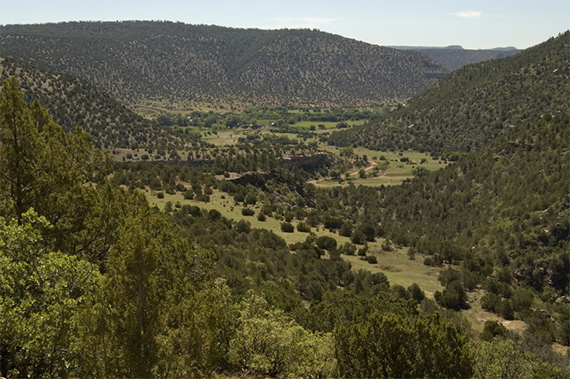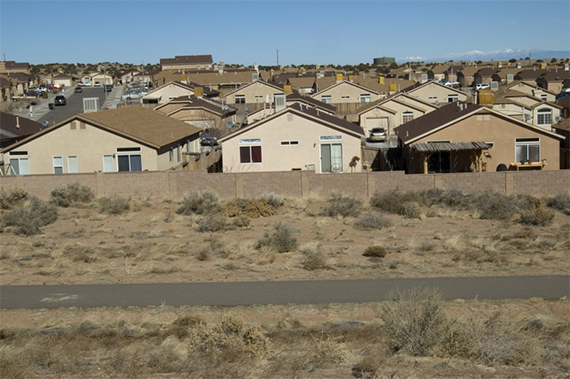Page 2
 (Looking down from the road at the Valley of San Agustin, which lies southeast of Las Vegas. In the middle it is greener due to irrigation from the Gallinas River.)
(Looking down from the road at the Valley of San Agustin, which lies southeast of Las Vegas. In the middle it is greener due to irrigation from the Gallinas River.)
In general, rivers large and small recharge aquifers, as does run-off from mountains that finds its way into faults and other geologic configurations. In periods of extended drought as serious as what we are experiencing now, very little recharge of ground water takes place. Traditionally, some 90% of New Mexico’s drinking water has come from underground sources. Recently some cities have been drinking Colorado River water provided by the San Juan-Chama Project, making them vulnerable to not only New Mexico’s draught but to extremely dry conditions in the Colorado River watershed.
Just characterizing all the surface and ground water resources in New Mexico is an immense and complicated task. When seen as part of much larger systems, such as the Colorado and Rio Grande watersheds, and the other states they connect us with, the picture becomes almost too vast to comprehend without considerable effort. But the relevant information exists and is, with work, graspable by non-experts.
II. Water law, water compacts and treaties, water customs and traditions, and legal skirmishes and warfare over water
This is an area of knowledge that seems so impossibly complex when you first encounter it that discouragement and dismissal are often reflexive responses. But if you stick with it for a while, the basics come clear.
The Colorado Compact of 1922 takes that massive river system and divvies it up among seven states –the upper basin states where the water comes from are Colorado, New Mexico, Wyoming, and Utah, and the lower basin states where half the water goes are California, Arizona, and Nevada. Both the upper and the lower basins have 7.5 million acre feet a year each to divide among themselves.
The tricky provision in a time of extended drought like ours is that over a ten year period the Upper Basin must deliver to the Lower Basin 75 million acre feet of water, and if the weather won’t permit it, the Upper Basin must curtail its use until it does. We were perilously close to that situation before the heavy snows in 2010-2011. And we are again. What this means for New Mexico is that the Colorado River water that we get through the San Juan-Chama project could be temporarily diminished or cut off, leaving Albuquerque, Santa Fe, the Middle Rio Grande Conservancy District, Espanola, Belen, Taos, and other locations without that additional water. Over the last three years, the San Juan Chama Project has supplied over 40 percent of Albuquerque’s drinking water.
The 1939 Rio Grande Compact between Colorado, New Mexico and Texas has recently come up in the news. Texas is suing New Mexico in the U.S. Supreme Court for not delivering what it considers its due under the Compact, contending that drought stricken New Mexico farmers are pumping too much water below Elephant Butte Dam and impeding the flow of the Rio Grande. Gary King, New Mexico Attorney General, said in a news release that Texas was just trying to “rustle New Mexico’s water” and ruin the lives of “hundreds of thousands of New Mexicans.”
Texas and New Mexico have gotten into it many times over water. In 1987, New Mexico lost a twenty year case to Texas over delivery of water under the 1949 Pecos River Compact from the years 1950 to 1983. Some legal experts here worry that New Mexico will lose the current case with Texas as well because it has chronically mismanaged its water over many decades – failing to delineate water rights, failing to monitor and restrain groundwater pumping for large scale agriculture (allowing corporate dairy farms, for instance, to use unlimited groundwater), and encouraging urban sprawl and growth untethered from water supply.
Aside from agreements between states, the principles of prior appropriation and beneficial use have a dominate place in water law in New Mexico and the American west. This is the situation, mentioned in California’s dispute with Arizona, where senior water rights holders get their water for beneficial use before junior rights holders in times of scarcity. But, there is a massive flaw in the application of these principles in the Middle Rio Grande Valley where Albuquerque sits. Hardly any senior water rights have been scrutinized and validated under a legal process called adjudication. So basically Albuquerque, and other municipalities in the area, who have junior rights, have the ability to grow by purchasing water rights from around the state, and avoiding the application of prior appropriation from senior users whose rights have not been validated. Some consider this a constitutional crisis that leads to an unsavory “commodification” of water to the detriment of small farming communities and acequia associations, any associated with traditional farming practices in northern New Mexico.
III. The size, growth patterns, and water use of major cities and the waterworks that feed them
It seems clear in hindsight, that Albuquerque, Rio Rancho, Santa Fe, and Las Cruces have outgrown their water means by leaps and bounds. They’ve become too big to sustain themselves at their current size. The post war growth explosion doubled the state’s population in less than 50 years. And as we grew, the lurking realities of global climate change and chronic drought remained largely invisible until the beginning of the 21st century. And even then climate change deniers kept pushing for more and faster growth.
 (Looking north over a walking path and a housing development above Albuquerque.)
(Looking north over a walking path and a housing development above Albuquerque.)
As cities boomed, local agriculture continued to retrench over all when compared to the years around WWI when the Rio Grande was known as the American Nile, watering a vast agricultural enterprise that exported food to California and other western cities. By the time the river was leveed and drainage ditches installed in the late l920s, the boom in agriculture had slowed down and was methodically, though not entirely, replaced in the Middle Rio Grande Valley by a growing suburban Albuquerque. In the middle of the first decade of the new century, New Mexico was importing more than 95 percent of its food, despite thriving dairy, chile, pecan and pistachio industries in the south, a revived agricultural enterprise by Pueblos and Navajos, and an ever-flourishing acequia culture and its produce in Northern New Mexico. A recent resurgence of farm to table and organic agriculture all over the state faces an uphill battle with drought and the aggressive predation of cities looking for agricultural water to buy or, as some contend, craftily steal by various means.
New Mexico’s water-hungry cities have sought to augment their use of groundwater by various means, including importing water from the Colorado River watershed through the San Juan-Chama project and buying water rights to agricultural water. Cities complain that farmers and ranchers waste water by using old fashioned technologies. Farmers and ranchers scoff, rebuking cities as the biggest water wasters of all. In the l990s, Albuquerque learned that its long vaunted aquifer was really not at all like an underground Lake Superior. It was limited in scope and was being drawn-down faster than anyone imagined. And unlike Los Angeles and Denver, Albuquerque and other major New Mexican cities were either not exploring or experimenting with how to recycle gray water and sewage water, in other words treating it and then reusing it, or were in only very the early stages of pilot projects. It’s only a matter of time, one hopes, when New Mexico realizes it is undergoing increasing desertification and moves to reuse every last drop of water it can.




Responses to “A systems approach to understanding water in New Mexico”